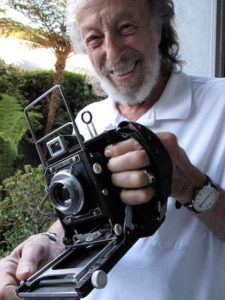
Herman Leonard
*Herman Leonard was born on this date in 1923. He was a white Jewish-American photographer known for his unique images of jazz icons. From Allentown, Pennsylvania, his parents, Joseph Leonard and Rose Morrison, were Romanian immigrants who emigrated from Yassi, Romania, to the United States.
Leonard earned a BFA in photography 1947 from Ohio University, although his college career was interrupted by a tour of duty in the U.S. Army during World War II. In the military, he served as a medical technician in Burma while attached to Chiang Kai Shek's Chinese troops fighting the Japanese. After graduation, Leonard apprenticed with portraitist Yousuf Karsh for one year. Karsh gave him valuable experience photographing celebrities and public personalities such as Albert Einstein, Harry Truman, and Martha Graham.
1948, Leonard opened his first studio at 220 Sullivan Street in Greenwich Village, New York. Working freelance for various magazines, he spent evenings at the Royal Roost and then Birdland, where he photographed the ongoing roster of jazz musicians such as Dexter Gordon, Charlie Parker, Dizzy Gillespie, Billie Holiday, Duke Ellington, Miles Davis, and others. The number of shots possible at a time was limited. Using glass negatives at this time, Leonard increased the sensitivity of the plates by exposing them to mercury vapor. After working for jazz record producer Norman Granz, who used his work on album sleeves, Leonard was employed in 1956 by Marlon Brando as his photographer to document an extensive research trip in the Far East.
Following his return, he moved to Paris, photographing assignments in the fashion and advertising business and as a European correspondent for Playboy Magazine. Leonard's last flurry of photographing jazz musicians dates from this period. Among the features he shot, one behind the Iron Curtain nearly landed him in a Polish jail. In 1980, Leonard, with his wife Elisabeth and two children, Shana and David, moved from Paris to the island of Ibiza, where he remained until 1988 when he relocated to London with his children. Here, Leonard had the first exhibition of his work at the Special Photographers Company in Notting Hill. Over ten thousand people, including singers Sade and Bono of U2, visited the exhibition.
The show toured the U.S. in 1989, and Leonard briefly moved to San Francisco. After an exhibition at the A Gallery for Fine Photography in New Orleans, he fell in love with the city and made it his home for the next fourteen years, immersing himself in its lively jazz and blues scene. He moved to Los Angeles after Hurricane Katrina flooded his New Orleans home and destroyed thousands of his prints. Leonard was considered one of the great mid-century jazz scene photographers. He started in the late 1940s and left a chronicle of a musical era with photos taken in New York, Paris, and London through the 1960s. The Smithsonian has more than 130 Leonard photographs in its permanent collection. Using a large 4-by-5 Speed Graphic camera, he shot countless jazz greats in the smoky haze of jazz clubs. His return to New Orleans was chronicled in the 2006 BBC/Sundance documentary "Saving Jazz."
In 2008, he was the first photographer granted a Grammy Foundation Grant for Preservation and Archiving, enabling him to digitize, catalog, and preserve his collection of nearly 60,000 jazz negatives. In 2009, he was the official photographer for the Montreal Jazz Festival, photographing legends such as Tony Bennett and Dave Brubeck. Jazz scene photographer Herman Leonard, famous for his smoky, backlighted black-and-white photos, died on August 14, 2010, in Los Angeles, California, and is survived by children Valerie, Shana, Michael, and David and six grandchildren.